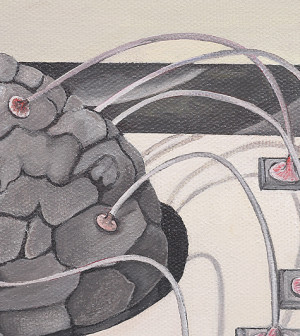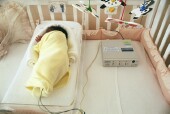- Navigating Your Midlife Crisis: Embracing New Possibilities
- City Raccoons Showing Signs of Domestication
- Mapping the Exposome: Science Broadens Focus to Environmental Disease Triggers
- One Week Less on Social Media Linked to Better Mental Health
- Your Brain Changes in Stages as You Age, Study Finds
- Some Suicide Victims Show No Typical Warning Signs, Study Finds
- ByHeart Formula Faces Lawsuits After Babies Sickened With Botulism
- Switch to Vegan Diet Could Cut Your Greenhouse Gas Emissions in Half
- Regular Bedtime Does Wonders for Blood Pressure
- Dining Alone Could Mean Worse Nutrition for Seniors
Brain Abnormality Spotted in Many SIDS Babies


A brain abnormality may be responsible for more than 40 percent of deaths from sudden infant death syndrome (SIDS), a new study suggests.
The abnormality is in the hippocampus, a part of the brain that influences breathing, heart rate and body temperature. This abnormality may disrupt the brain’s control of breathing and heart rate during sleep or during brief waking that happens during the night, the researchers report.
“This abnormality could put infants at risk for SIDS,” said lead researcher Dr. Hannah Kinney, a professor of pathology at Harvard Medical School in Boston.
Kinney can’t say for sure that this abnormality is a cause of SIDS. “We don’t know at this stage. This is the first observation of this abnormality,” she said. “It’s just an observation at this point.”
Before this brain abnormality can be called a cause of SIDS, Kinney said, they have to find out what causes this abnormality and determine if it alone can cause SIDS.
For the study, Kinney’s team examined sections of the hippocampus from 153 infants who died suddenly and unexpectedly between 1991 and 2012. The deaths were classified as unexplained — which includes SIDS — or from a known cause, such as infection, accident, murder or lack of oxygen.
Kinney’s group found that 41.2 percent of infants who died for an unexplained reason compared with 7.7 percent of those whose death was explainable had an abnormality in the part of the hippocampus known as the dentate gyrus.
Among the 86 infants whose death was classified as SIDS, 43 percent had this abnormality, the researchers added.
This change in the dentate gyrus suggests there was a problem in development at some point late in the life of the fetus or in the months after birth, Kinney said.
Kinney added that this abnormality has only been seen under the microscope after death, so a child cannot be tested for the abnormality.
“There are no signs or symptoms that predict SIDS or warn families that this problem is there or that SIDS is going to occur,” she said.
The report was published online Nov. 24 in the journal Acta Neuropathologica.
“Until we understand more about this abnormality, parents should follow the safe sleep recommendations of the American Academy of Pediatrics,” Kinney said.
The recommendation is to place an infant alone in a crib on the back without toys or pillows as bolsters. “The same messages we have always had are still applicable,” she said.
SIDS is the leading cause of death of infants younger than 1 year of age in the United States, the researchers said.
Dr. Sayed Naqvi, a pediatric neurologist at Miami Children’s Hospital, noted that this brain abnormality has been found in epilepsy, but this is the first time it has been linked to SIDS.
“This needs to be confirmed and more research done to say this is a cause of SIDS,” he said.
Marian Willinger, a special assistant for SIDS at U.S. National Institute of Health’s Eunice Kennedy Shriver National Institute of Child Health and Human Development, said in a statement, “The new finding adds to a growing body of evidence that brain abnormalities may underlie many cases of SIDS.”
“The hope is that research efforts in this area eventually will provide the means to identify vulnerable infants so that we’ll be able to reduce their risk for SIDS,” she added.
More information
Visit the U.S. Centers for Disease Control and Prevention for more on SIDS.
Source: HealthDay
Copyright © 2025 HealthDay. All rights reserved.










